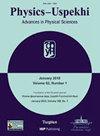互联网物理新闻:2023年11月
IF 3.4
3区 物理与天体物理
Q1 PHYSICS, MULTIDISCIPLINARY
引用次数: 0
摘要
本文章由计算机程序翻译,如有差异,请以英文原文为准。
Physics news on the Internet: November 2023
VVDmitriev (P LKapitza IPPRAS) and his co-authors have become the first to carry out the observation of b-phase of superfluid He in nematic aerogel in a strong magnetic field [1]. Under ordinary conditions, superfluid He has only two phases (A and B). In a strongmagnetic field, however, it splits into new phases with different spin compositions of an ensemble of Cooper pairs. If, in addition, He is confined in nematic aerogel (a loose medium of siliceous filaments or another substance) with co-directed filaments, then a strong anisotropy and a polar phasemay appear. EV Surovtsev (IPP RAS and MIPT) predicted in [2, 3] that, under such conditions, He, when cooled, will transfer to the so-called b-phase instead of the purely polar phase, and then to a deformed b-phase with further cooling. Used in the new experiment was nematic aerogel of mullite (a mineral of the silicate class) with elongated pores, in which solid He layers on the filament surface were replaced by He. The aerogel was fixed in a mechanical cavity, and the resonance properties of this system as a function of temperature were examined. The transition of He into one phase or another was accompanied by a change in the superfluid component density and thus affected the resonant frequency and the shape of the resonance curve. This method was used to register the predicted transitions to a superfluid b-phase and a deformed b-phase. The temperature range of the b-phase was found to be proportional to the magnetic field value. For superfluid He phases in aerogel, see also [4].
求助全文
通过发布文献求助,成功后即可免费获取论文全文。
去求助
来源期刊

Physics-Uspekhi
物理-物理:综合
CiteScore
4.70
自引率
7.40%
发文量
60
审稿时长
6-12 weeks
期刊介绍:
Physics-Uspekhi (Advances in Physical Sciences) is a translation of the authoritative Russian-language review journal in physics, Uspekhi Fizicheskikh Nauk, first published in 1918. The papers cover a wide spectrum of the world''s scientific research in physics and associated fields by authors from France, Germany, United Kingdom, Italy, Japan, Sweden, the USA and other countries which successfully complement contributions by authors from Russia and other states of the former Soviet Union.
Physics-Uspekhi (Advances in Physical Sciences) covers:
Reviews of Topical Problems
Physics of Our Day
Instruments and Methods of Investigation
Methodological Notes
From the History of Physics
Conferences and Symposia
Book Reviews
Selected Physics News from the Internet.
 求助内容:
求助内容: 应助结果提醒方式:
应助结果提醒方式:


